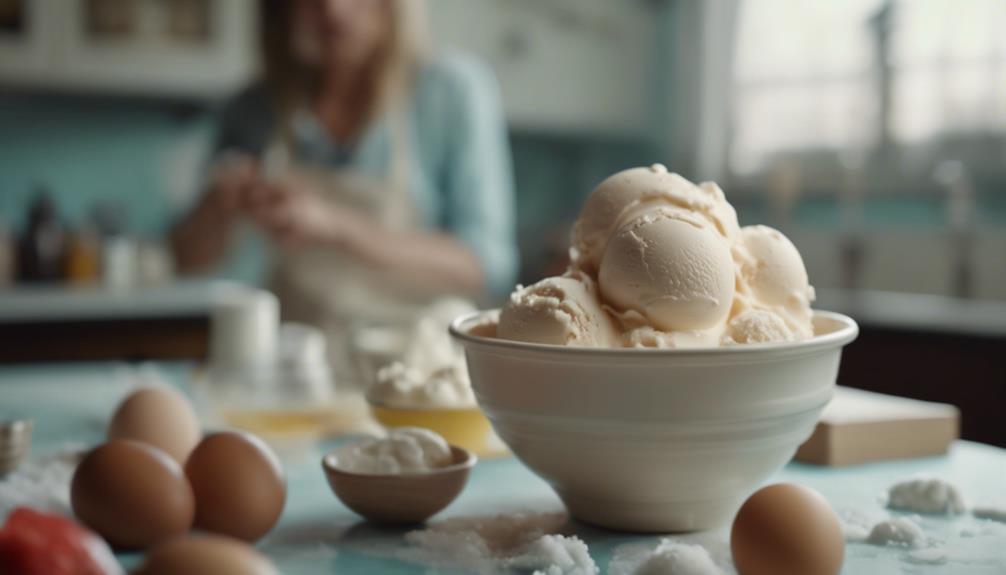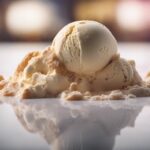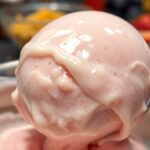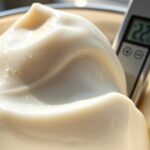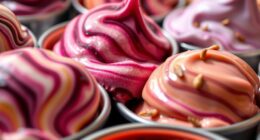If your homemade ice cream tastes waxy, adjust the fat content, monitor temperatures, use stabilizers, and guarantee proper heating and cooling. Balancing these factors can fix the issue.
Key Takeaways
- Monitor temperature to avoid overheating.
- Strain base before churning for smoothness.
- Adjust fat content to prevent waxy mouthfeel.
- Use stabilizers like cornstarch for texture.
- Experiment with milk and cream ratios.
Understanding Waxy Ice Cream Texture
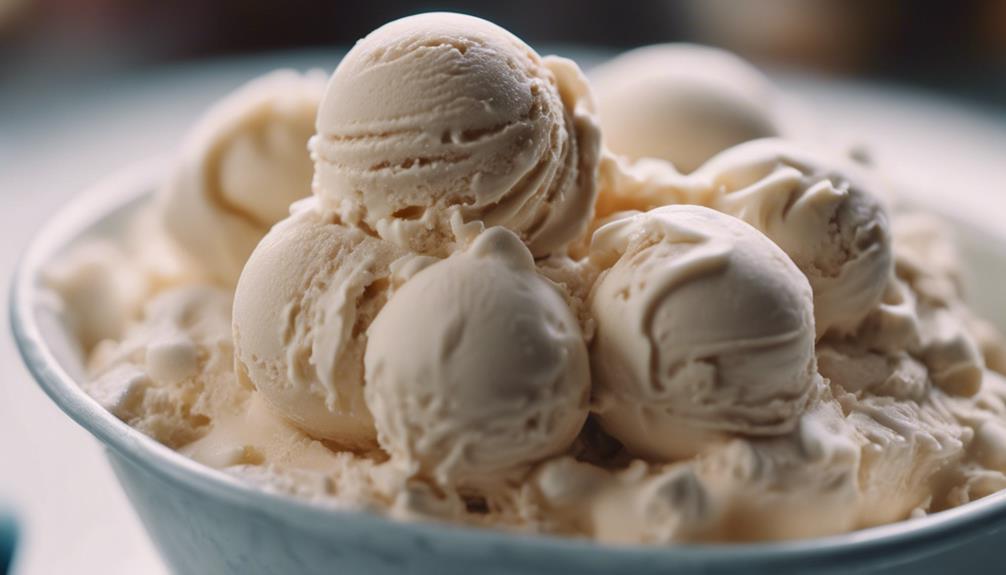
To avoid a waxy texture in your homemade ice cream, make sure you heat the cream and milk mixture within the essential temperature range of 83 to 86 degrees Celsius. Failure to maintain proper temperature control during this critical step can result in a less-than-ideal ice cream base, leading to the undesired waxy texture in your final product. Monitoring the temperature with a reliable thermometer is key to preventing overheating, which can also contribute to the waxy mouthfeel.
When preparing your ice cream base, make certain that you strain it through a fine mesh strainer before cooling. This step helps remove any potential waxy particles that may have formed during the heating process.
Recipe Adjustments for Better Texture
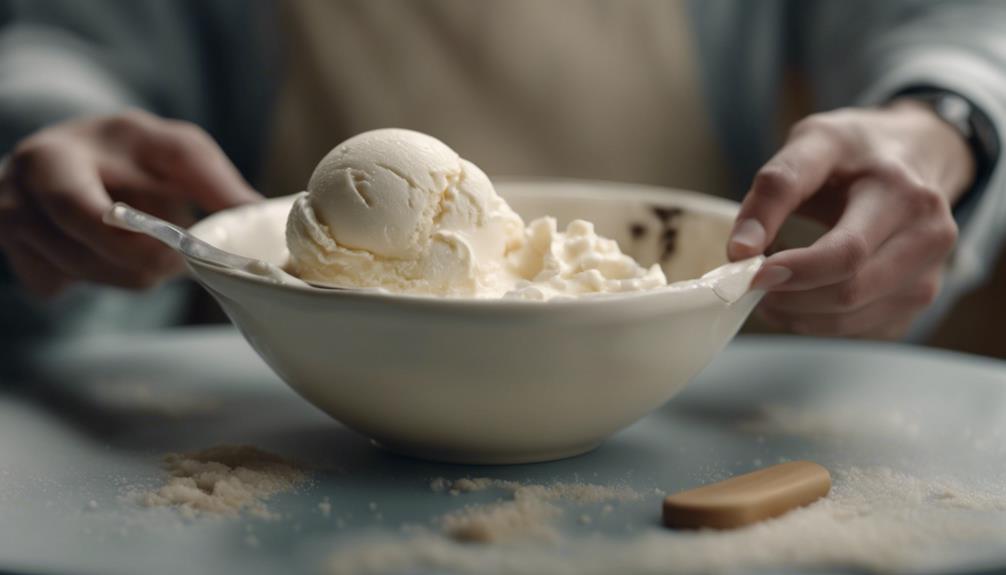
To enhance the texture of your homemade ice cream, consider adjusting the fat content in your recipes to avoid a waxy mouthfeel.
Using a thermometer to monitor temperatures when heating and cooling the mixture can help you achieve the perfect consistency.
Straining the ice cream base and incorporating stabilizers like cornstarch or egg yolks can also improve the overall texture of your frozen treat.
Texture-Enhancing Recipe Tweaks
Enhancing the texture of your homemade ice cream can be achieved by adjusting key elements in your recipe. To improve the texture and prevent a waxy mouthfeel, consider tweaking the fat content. Too much fat can lead to a greasy texture, while too little can result in iciness. Finding the right balance is vital for a creamy consistency.
Incorporating stabilizers like cornstarch or gelatin can also help enhance the texture of your ice cream. These ingredients prevent ice crystals from forming, resulting in a smoother mouthfeel.
Additionally, pay attention to the sugar content in your base mixture. Balancing the sweetness can impact the overall texture of the ice cream. Too much sugar can make the ice cream overly soft, while too little can cause it to freeze too hard.
Experimenting with a combination of milk and cream in your recipe can further contribute to a velvety smooth texture. Properly heating and cooling the base mixture before churning is essential for achieving the desired creaminess in your homemade ice cream.
Ingredient Balance Tips
Maintaining the right balance of ingredients is important for achieving the desired texture in your homemade ice cream. When it comes to ingredient balance, the fat content plays a pivotal role in determining whether your ice cream will turn out smooth or waxy.
To prevent a waxy texture, it's important not to exceed a 16% fat content in your ice cream base. Adjusting the ratio of milk to cream can help distribute the fat more evenly throughout the mixture, leading to a better texture overall.
While cream contributes to the richness of the ice cream, too much of it can result in that undesirable waxy sensation. By carefully balancing the fat content and other ingredients in your ice cream recipe, you can guarantee a creamy and delightful treat that's free from any unwanted textures.
Consistency Improvement Methods
Improving the consistency of your homemade ice cream can be achieved by making specific recipe adjustments that target texture enhancements. When aiming for a creamier texture and avoiding a waxy mouthfeel, consider the following:
- Adjust fat content: Maintaining a proper balance of fat in your ice cream recipe can help prevent a waxy texture.
- Incorporate stabilizers: Adding stabilizers like cornstarch or gelatin can enhance consistency and reduce waxiness.
- Ensure proper heating and cooling: Pay attention to heating and cooling your ice cream base to specific temperatures to prevent a waxy mouthfeel.
- Avoid over-churning: Be cautious not to over-churn the ice cream mixture, as excessive air incorporation can lead to a waxy texture.
Managing Fat Content Effectively
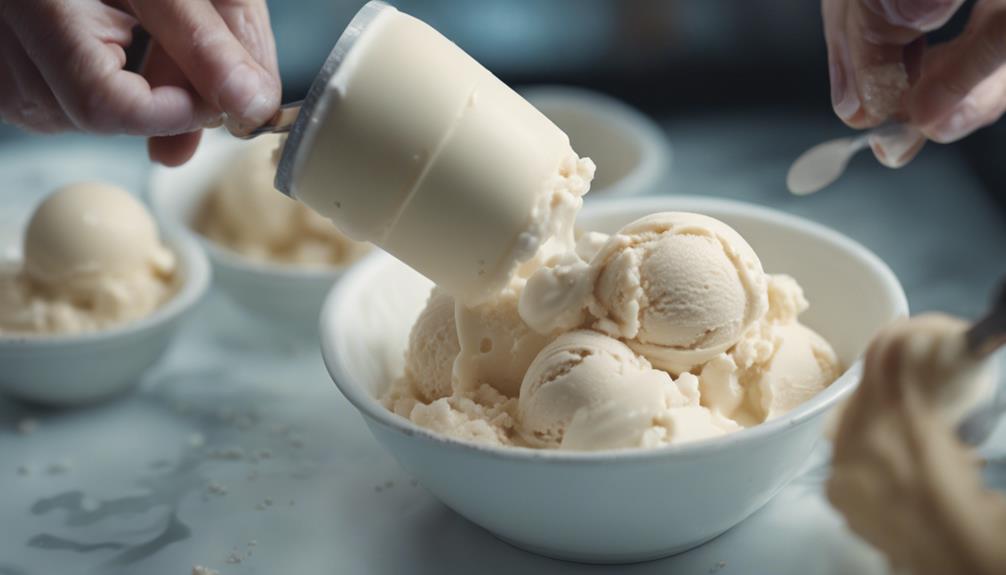
To achieve a smoother texture in your homemade ice cream, it's pivotal to balance the ratio of milk to cream effectively. The fat content plays a significant role in determining the texture of your ice cream. Ideally, the fat content shouldn't exceed 16% to avoid a waxy mouthfeel.
Cream contains around 40% fat, while milk has about 3% fat. By carefully adjusting the amounts of cream and milk in your recipe, you can control the overall fat content of your ice cream base.
It is important to make sure that the fat is evenly distributed throughout the base to prevent the development of a waxy texture in your final product. High fat content can lead to a less desirable mouthfeel in your ice cream.
Hence, managing the fat levels effectively is key to achieving a creamy and smooth consistency in your homemade ice cream. By maintaining a balanced fat content, you can enjoy a delightful treat without the unwanted waxy texture.
Importance of Temperature Control
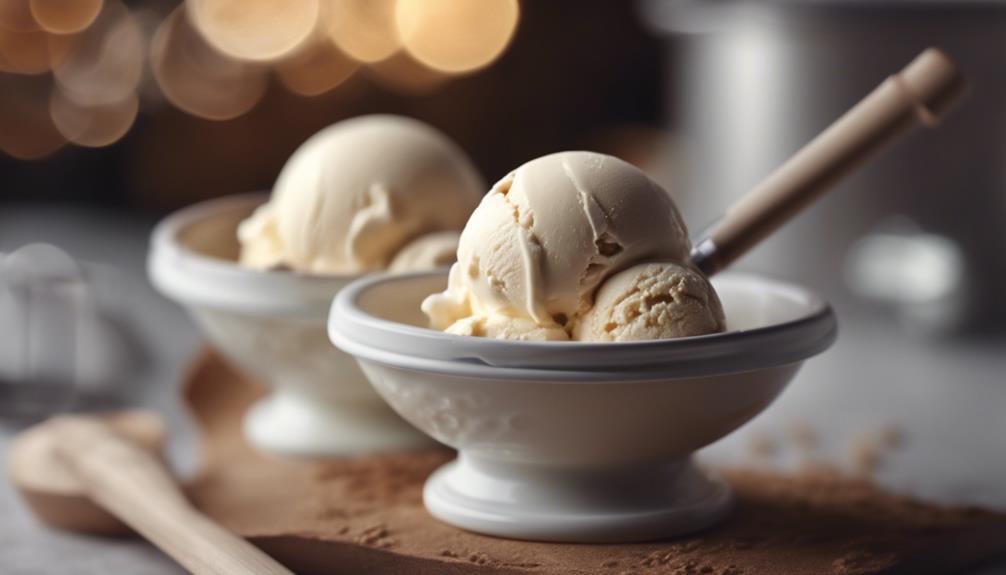
For best results in your homemade ice cream, ensuring precise temperature control is essential. To achieve that smooth texture you desire, pay close attention to the temperature throughout the ice cream-making process.
Here are some key points to keep in mind:
- Maintain the Right Temperature: Keep the temperature between 77-79C (170-175F) to prevent a waxy texture in your homemade ice cream.
- Avoid Overheating: Make sure not to exceed 80C (176F) when heating the ice cream mixture to maintain a smooth consistency.
- Add Vanilla Seeds Carefully: If using a vanilla bean, add the seeds after straining to control the temperature impact on the texture.
- Infuse Flavor Mindfully: Take into account simmering the vanilla bean pod with cream and milk to infuse flavor while managing the temperature for a creamy outcome.
Troubleshooting Churning and Freezing
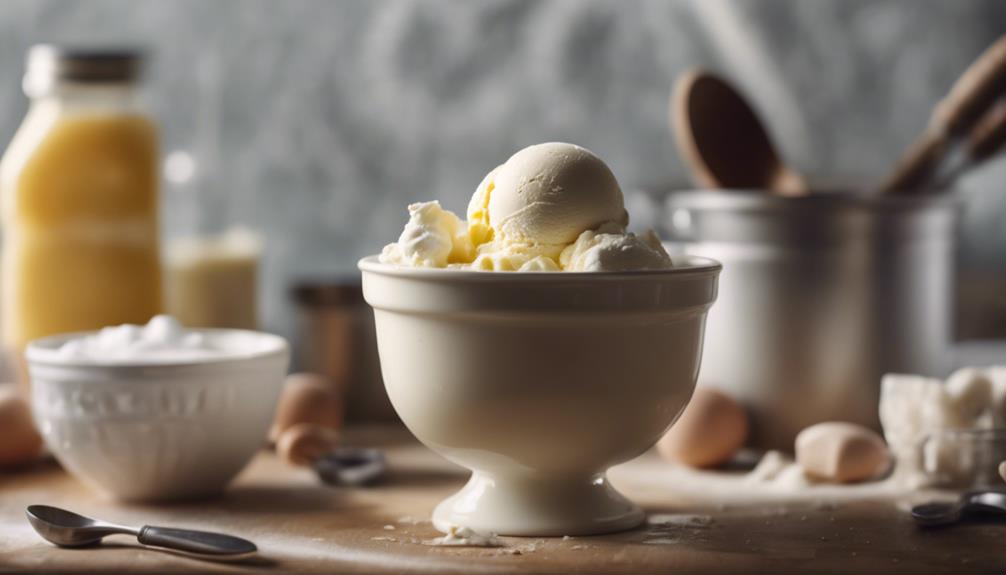
When troubleshooting churning and freezing homemade ice cream, make certain that your churning process is consistent to avoid a waxy texture in the final product. Uneven churning can lead to a less than ideal outcome.
Make sure that the churning process evenly incorporates air into the mixture. This step is vital as the right amount of air helps give the ice cream a light, creamy texture.
Additionally, freeze the mixture at the recommended temperature for the specified duration. Inadequate freezing time or temperature can result in a waxy mouthfeel.
Be careful not to over-churn the ice cream as this can cause excessive fat destabilization leading to a waxy consistency.
Moreover, keep an eye on your equipment. Improper machine maintenance or malfunction can impact the freezing process, resulting in a less than desirable texture. Temperature fluctuations during freezing can also contribute to a waxy feel in homemade ice cream.
Equipment and Ingredient Recommendations
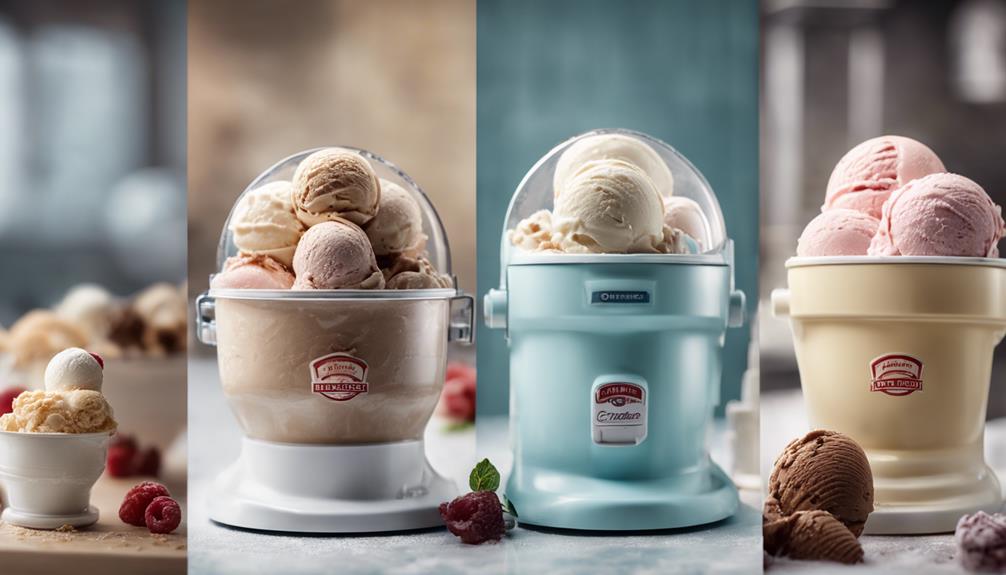
When making homemade ice cream, selecting the right equipment is essential for the perfect texture. Quality ingredients like fresh dairy and stabilizers can greatly improve the outcome of your ice cream.
Equipment Selection Tips
Consider selecting an ice cream maker with a dependable freezing mechanism to guarantee consistent results when making homemade ice cream.
When choosing equipment for your ice cream-making endeavors, keep these tips in mind:
- Invest in a quality ice cream maker: Look for a machine that can freeze ice cream efficiently to achieve the desired creamy texture.
- Opt for a digital thermometer: Monitoring temperatures accurately is essential in the ice cream-making process to ensure the perfect consistency.
- Consider a machine with a built-in compressor: This feature allows for precise temperature control, resulting in smoother and creamier homemade ice cream.
- Choose well-insulated containers: Sturdy containers help maintain the best temperature of your homemade ice cream, preventing it from developing a waxy texture.
Ingredient Quality Importance
For best results in making homemade ice cream, prioritize the quality of your ingredients, focusing on dairy products with the right fat content and fresh, premium ingredients.
Using high-quality dairy products is essential for achieving a creamy texture and rich flavor in your ice cream. Opt for ingredients like organic milk and cream to enhance the overall quality of your dessert. The fat content in your dairy products plays a significant role in preventing a waxy mouthfeel in your homemade ice cream.
Investing in premium ingredients will elevate the taste and texture of your final product, making it a delightful treat for you and your family. By choosing high-quality dairy products, you set the foundation for a delicious and smooth homemade ice cream experience.
Make sure to select fresh, natural flavorings and avoid artificial additives to maintain the integrity of your dessert. Your ice cream will taste so much better with these premium ingredients.
Texture Improvement Techniques
To enhance the texture of your homemade ice cream, invest in a high-quality ice cream maker with a reliable freezing mechanism. When churning your ice cream, consider the following tips to improve its texture:
- Balance Cream and Milk: Opt for recipes with a well-balanced ratio of cream and milk to prevent the formation of large ice crystals that can result in a waxy mouthfeel.
- Avoid Overheating: Be cautious not to overheat the ice cream base as this can lead to a grainy texture. Heat gently until just simmering to maintain a smooth and creamy consistency.
- Incorporate Stabilizers: Consider adding stabilizers like corn syrup or tapioca starch to enhance creaminess and prevent the development of a waxy texture in your ice cream.
- Experiment with Fat Content: Try varying the fat percentages in your base to find the perfect balance between richness and smoothness for your homemade ice cream.
Frequently Asked Questions
Why Does My Ice Cream Taste Waxy?
When your ice cream tastes waxy, it's likely due to incorrect temperatures during the preparation. Make sure you heat the cream and milk mixture to 83-86 degrees Celsius and avoid exceeding 80 degrees Celsius to prevent this texture issue.
Why Does Homemade Ice Cream Leave a Film in Your Mouth?
When homemade ice cream leaves a film in your mouth, it may be due to an imbalance in fat content or improper heating during preparation. Avoid overheating the mixture, strain before churning, and maintain temperature control for a smoother texture.
How Do You Make Homemade Ice Cream Taste Better?
To make homemade ice cream taste better, adjust the fat content for a smoother texture. Control the heating temperature between 77-79C. Add vanilla seeds for enhanced flavor. Balance milk to cream ratio. Monitor temperature with a thermometer.
Why Is My Homemade Ice Cream Gummy?
When homemade ice cream turns gummy, it's like trying to scoop cement! Avoid this sticky situation by ensuring you don't over-churn the mix, skimp on fat, undermix air, overheat the base, or overload on sugar.
How Can I Fix the Waxy Texture of My Homemade Ice Cream?
If you’re dealing with grainy ice cream, the causes and solutions for grainy ice cream may vary. To fix the waxy texture of your homemade ice cream, try reducing the amount of stabilizers or over-churning the mixture. Another solution is to ensure the base is properly chilled before churning.
Conclusion
You've learned how to tackle that pesky waxy texture in your homemade ice cream like a pro! With a few simple recipe adjustments and temperature control tips, you'll be churning out creamy, dreamy batches in no time.
So go ahead, scoop up that silky smooth ice cream like a kid in a candy store and savor every bite!
